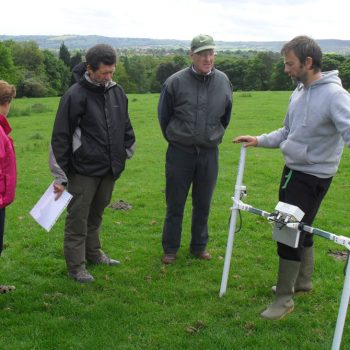All Categories
Featured
Table of Contents
Geophysical Surveys - Mining, Exploration And Geoscience in Bassendean Aus 2020
Much of the image consists of blank areas now with little or no radar reaction. The "yard" wall is still revealing strongly, nevertheless, and there are continuing suggestions of a tough surface area in the SE corner. Time piece from 23 to 25ns. This last piece is now nearly all blank, however a few of the walls are still showing highly.
How deep are these pieces? The software application I have access to makes estimating the depth a little difficult. If, however, the leading three pieces represent the ploughsoil, which is probably about 30cm think, I would guess that each piece is about 10cm and we are just getting down about 80cm in total.

Luckily for us, the majority of the sites we have an interest in lie simply listed below the plough zone, so it'll do! How does this compare to the other methods? Comparison of the Earth Resistance data (top left), the magnetometry (bottom left), the 1517ns time piece (top right) and the 1921ns time slice (bottom left).
Geophysical Survey Methods in Mount Lawley Oz 2023
Magnetometry, as discussed above, is a passive strategy determining regional variations in magnetism against a localised no worth. Magnetic susceptibility study is an active technique: it is a measure of how magnetic a sample of sediment might be in the existence of a magnetic field. Just how much soil is checked depends on the size of the test coil: it can be very little or it can be fairly big.
The sensor in this case is extremely small and samples a tiny sample of soil. The Bartington magnetic vulnerability meter with a big "field coil" in usage at Verulamium during the course in 2013. Top soil will be magnetically improved compared to subsoils merely due to natural oxidation and decrease.
By determining magnetic vulnerability at a relatively coarse scale, we can discover areas of human occupation and middens. We do not have access to a reputable mag sus meter, however Jarrod Burks (who helped teach at the course in 2013) has some outstanding examples. One of which is the Wildcat site in Ohio.
Airborne Geophysical Methods in Wattleup Australia 2020
These towns are frequently set out around a central open location or plaza, such as this reconstructed example at Sunwatch, Dayton, Ohio. Sunwatch Town, Dayton, Ohio (image: Jarrod Burks). At the Wildcat site, the magnetometer survey had located a range of functions and homes. The magnetic vulnerability study assisted, nevertheless, specify the primary location of profession and midden which surrounded the more open area.
Jarrod Burks' magnetic vulnerability survey arises from the Wildcat site, Ohio. Red is high, blue is low. The strategy is for that reason of terrific use in specifying locations of basic profession rather than identifying particular functions.
Geophysical surveying is a used branch of geophysics, which utilizes seismic, gravitational, magnetic, electrical and electro-magnetic physical methodologies at the Earth's surface area to measure the physical homes of the subsurface - Surface Geophysical Methods - Us Epa in Spearwood WA 2022. Geophysical surveying techniques normally determine these geophysical homes in addition to abnormalities in order to evaluate various subsurface conditions such as the presence of groundwater, bedrock, minerals, oil and gas, geothermal resources, spaces and cavities, and far more.
Table of Contents
Latest Posts
Glad You Asked: What Are Seismic Surveys? in Mt Helena Oz 2023
Geophysical Survey Services - Geophysical Test Methods in East Fremantle Oz 2021
Marine Geophysical Surveying - in Butler Oz 2021
More
Latest Posts
Glad You Asked: What Are Seismic Surveys? in Mt Helena Oz 2023
Geophysical Survey Services - Geophysical Test Methods in East Fremantle Oz 2021
Marine Geophysical Surveying - in Butler Oz 2021